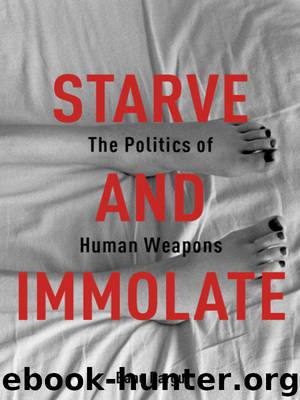Starve and Immolate by Bargu Banu

Author:Bargu, Banu
Language: eng
Format: epub
Tags: PHI019000, Philosophy/Political, POL035010, Political Science/Political Freedom & Security/Human Rights
Publisher: Columbia University Press
Published: 2014-09-15T16:00:00+00:00
Chapter 5
Marxism, Martyrdom, Memory
For the extraparliamentary, illegal leftist opposition in Turkey, the adoption of the weaponization of life as the predominant tactic of struggle entailed an existential and passionate commitment to Marxism. The radical organizations that participated in the death fast struggle subscribed to different currents of Marxism, which provided diverse readings of world politics and Turkey’s role within it, the history of the country, the level of its socioeconomic development and nature of its production relations, and the character of the state, prescribing in turn the different revolutionary strategies to be followed and the forms of organization best suited for their favored strategy. While these differences, further complicated by local debates, historical events, social networks, and particular experiences, soon hardened into distinct group identities and endowed the left with a highly sectarian culture, the commitment to Marxism nonetheless constituted a common moral compass, which guided generations of militants against the injustice of the capitalist economy and the oppression of the state. As a moral compass, Marxism drew the dividing line between right and wrong, between the just and the unjust. It was therefore thanks to their existential commitment that militants of different organizational affiliations and ideological convictions could see themselves as standing together on the same side of that line, transcending the differences among them.
In prison this existential commitment found its expression as the willingness to sacrifice one’s life for the revolutionary cause. It developed out of and in turn further developed a cultural repertoire of conduct that was deeply oppositional to the forms of conduct required, encouraged, and affirmed as appropriate for prisoners by the state, laws and regulations, governmental decrees and circulars, and the orders of prison administrators. Collective life in ward communes as alternative modes of sociality already prescribed in detailed manner how each prisoner should conduct oneself in prison. Moreover, the intense periods of collective resistance against the arbitrary and violent intrusions of the state, built upon the spatial experience of the prison wards, further delineated a clear framework of counterconduct based on corporeal practices that required self-discipline, solidarity, dedication, and conviction. This repertoire of conduct helped transform prisoners on an individual level and gave them the power, determination, and courage to refuse obedience to the state. It enabled them to carry out acts of self-destruction and assert their political agency as a group from a position of intense marginality.
However, the growing centrality of necroresistance as a form of collective counterconduct also enacted a profound transformation in the politics of Marxist organizations and their supporters. The novel orientation toward death in the discursive and practical world of the radical left led to the development of what Foucault has called a “political spirituality.”1 This political spirituality not only altered the ideological views of these organizations and those of their militants but also produced elaborate rituals that have come to assume a vital function for the way in which ideology is lived and reproduced. Martyrdom became the main element of this spirituality and the resource with which
Download
This site does not store any files on its server. We only index and link to content provided by other sites. Please contact the content providers to delete copyright contents if any and email us, we'll remove relevant links or contents immediately.
| Anarchism | Communism & Socialism |
| Conservatism & Liberalism | Democracy |
| Fascism | Libertarianism |
| Nationalism | Radicalism |
| Utopian |
The Secret History by Donna Tartt(18951)
The Social Justice Warrior Handbook by Lisa De Pasquale(12170)
Thirteen Reasons Why by Jay Asher(8848)
This Is How You Lose Her by Junot Diaz(6837)
Weapons of Math Destruction by Cathy O'Neil(6220)
Zero to One by Peter Thiel(5736)
Beartown by Fredrik Backman(5682)
The Myth of the Strong Leader by Archie Brown(5461)
The Fire Next Time by James Baldwin(5386)
How Democracies Die by Steven Levitsky & Daniel Ziblatt(5175)
Promise Me, Dad by Joe Biden(5117)
Stone's Rules by Roger Stone(5053)
A Higher Loyalty: Truth, Lies, and Leadership by James Comey(4909)
100 Deadly Skills by Clint Emerson(4882)
Rise and Kill First by Ronen Bergman(4741)
Secrecy World by Jake Bernstein(4703)
The David Icke Guide to the Global Conspiracy (and how to end it) by David Icke(4658)
The Farm by Tom Rob Smith(4468)
The Doomsday Machine by Daniel Ellsberg(4452)
